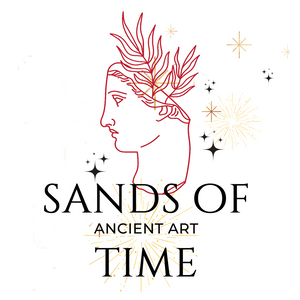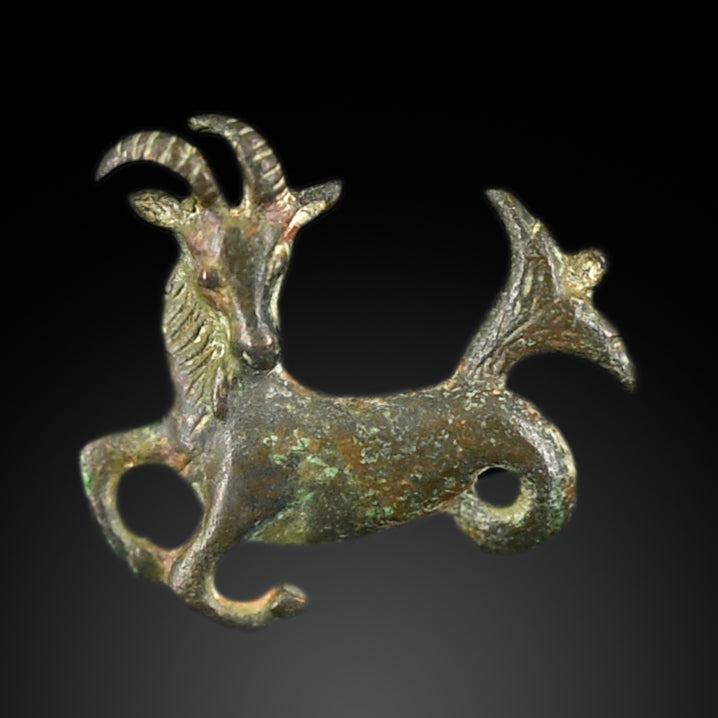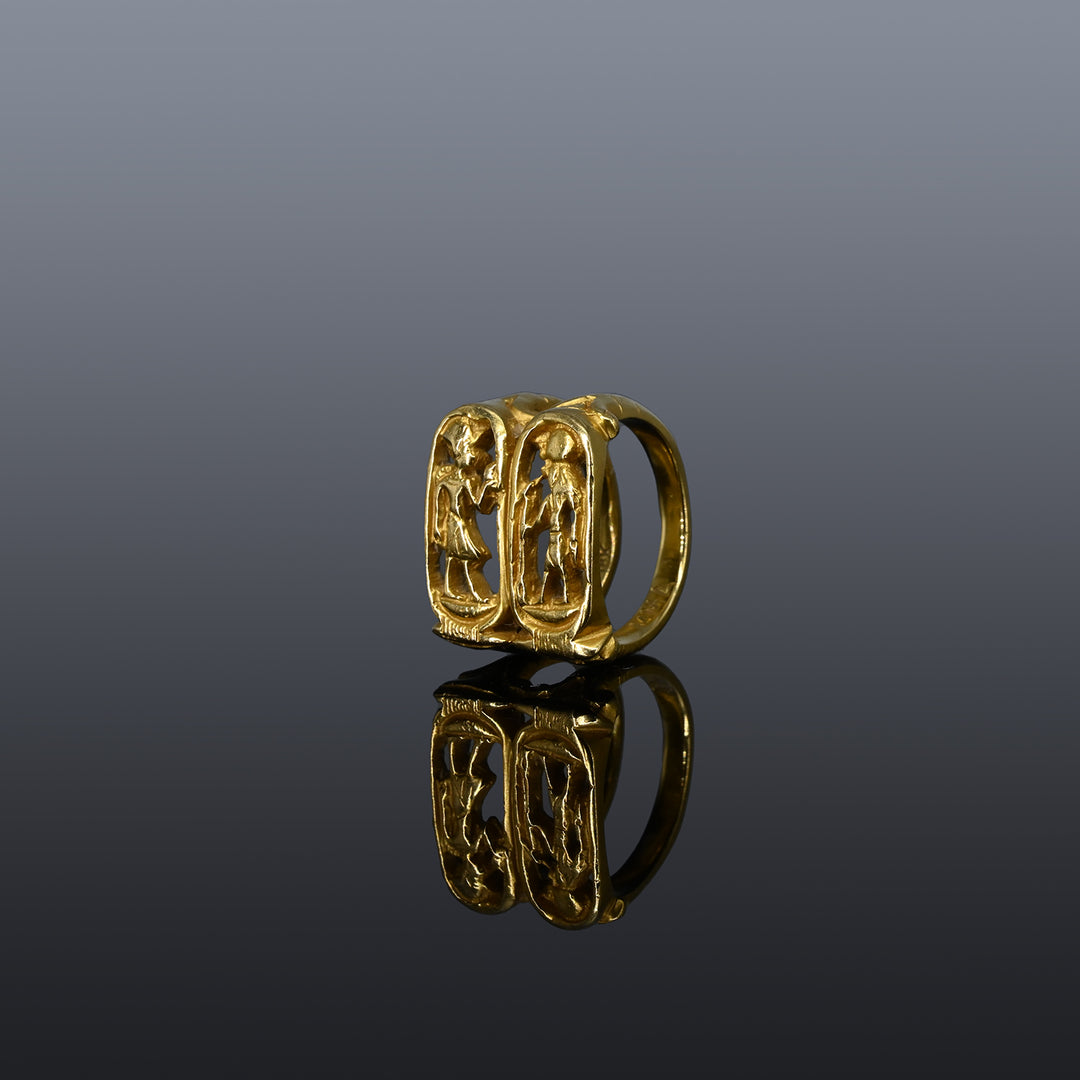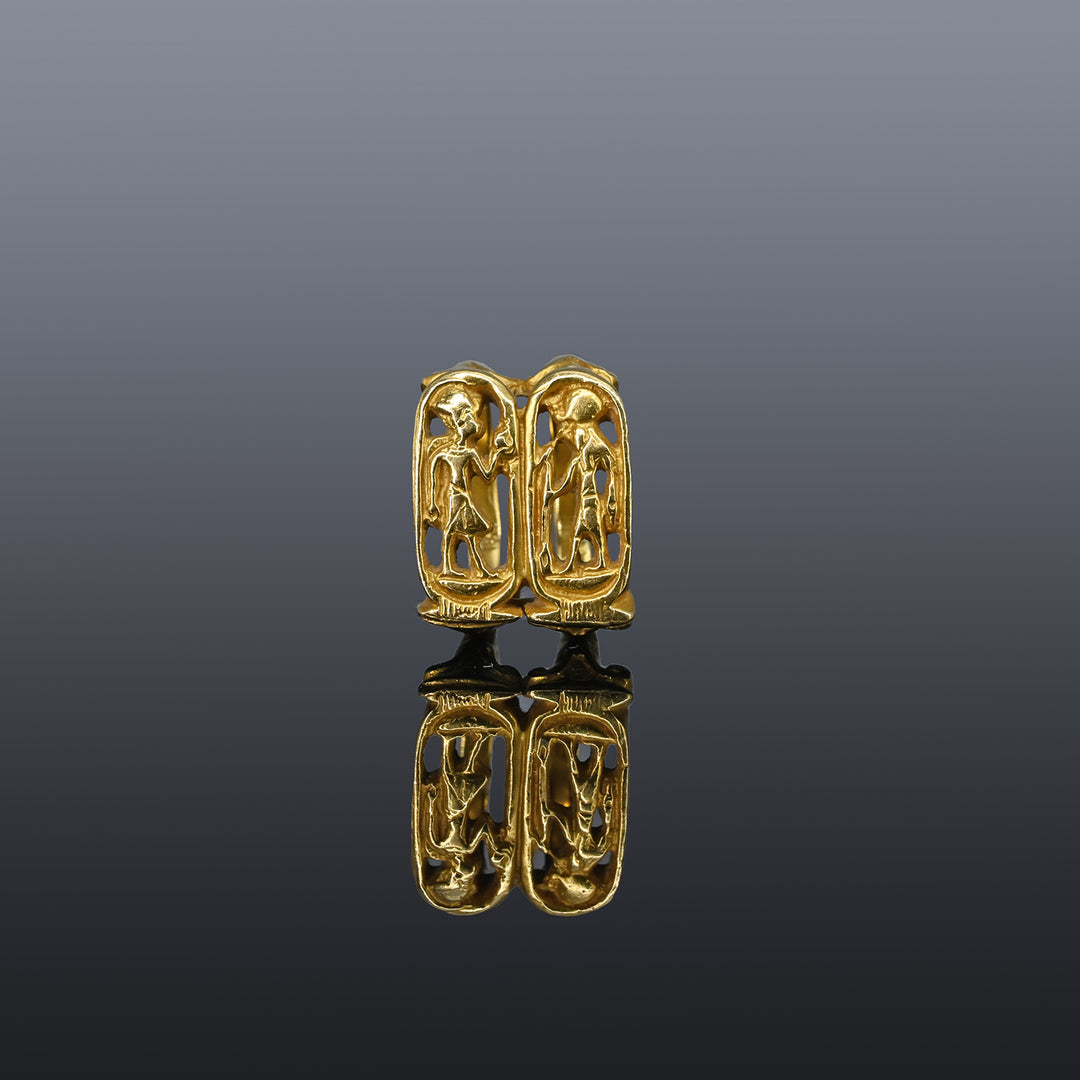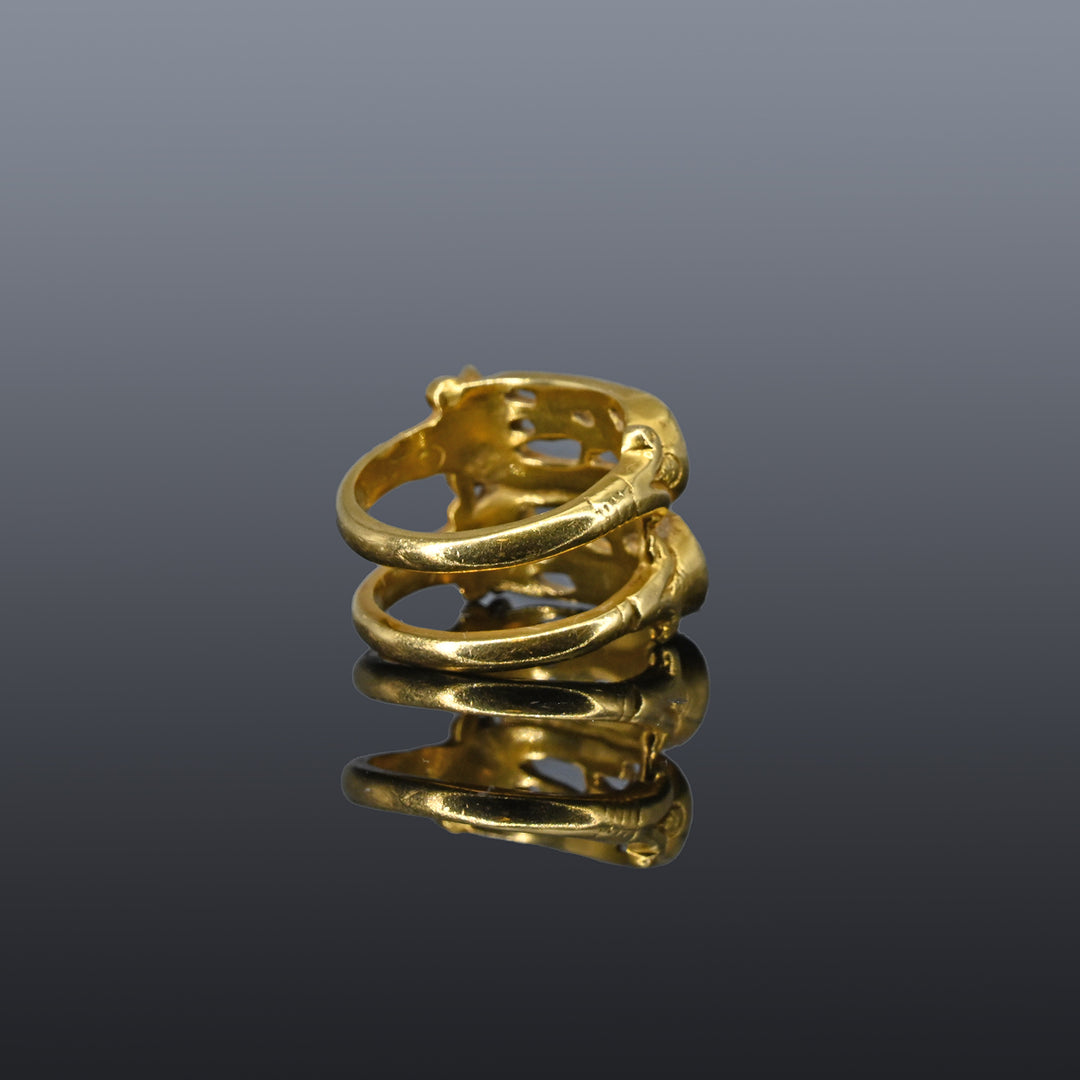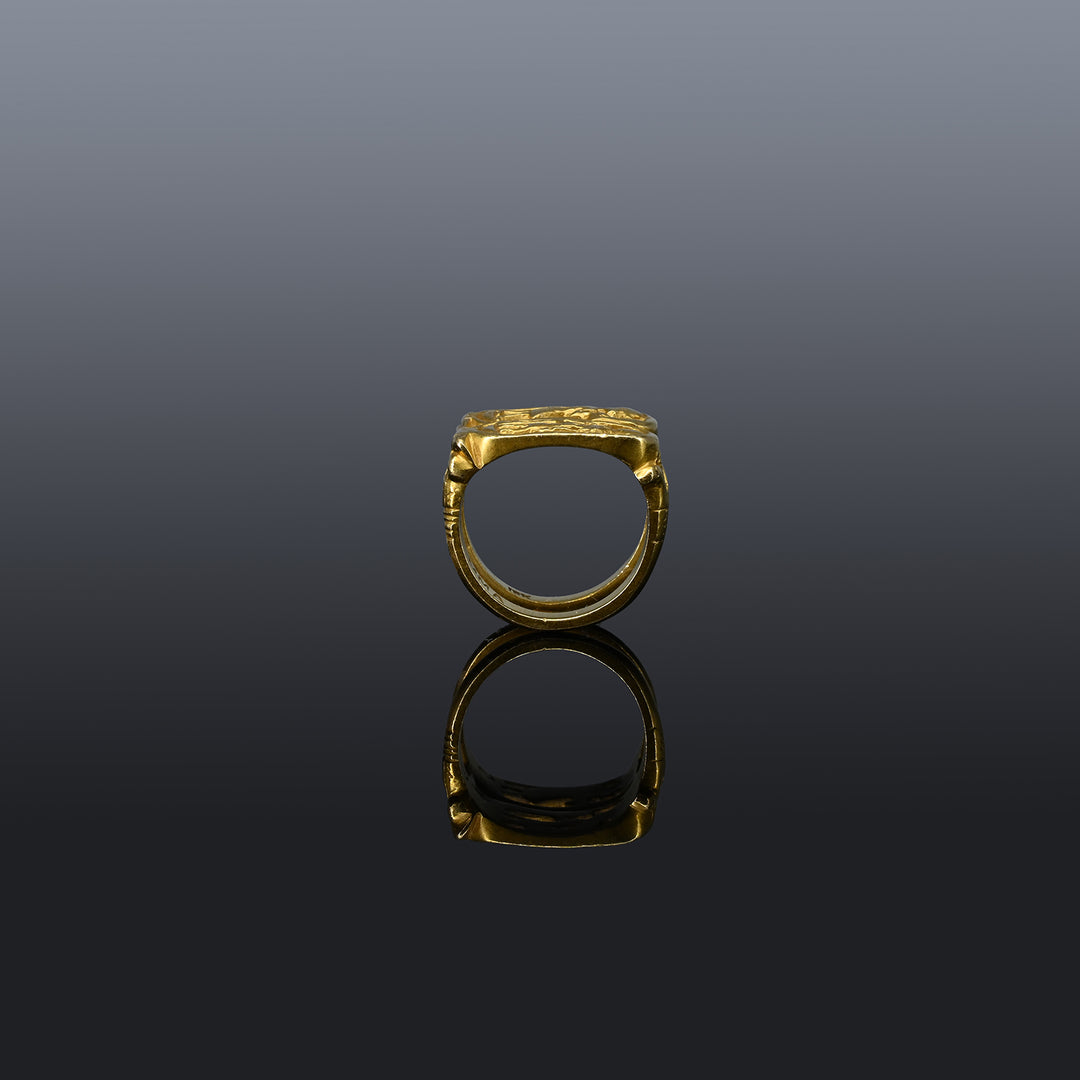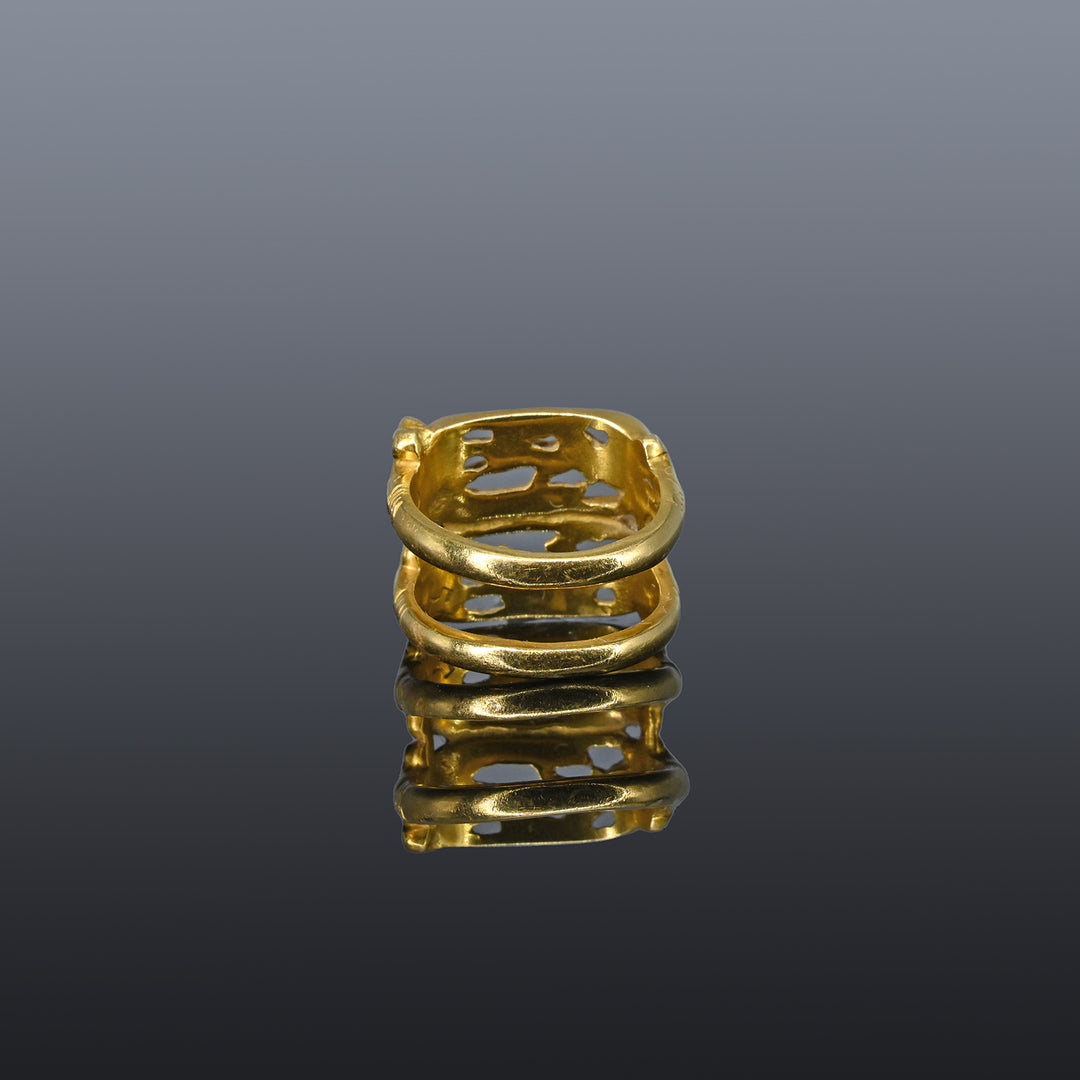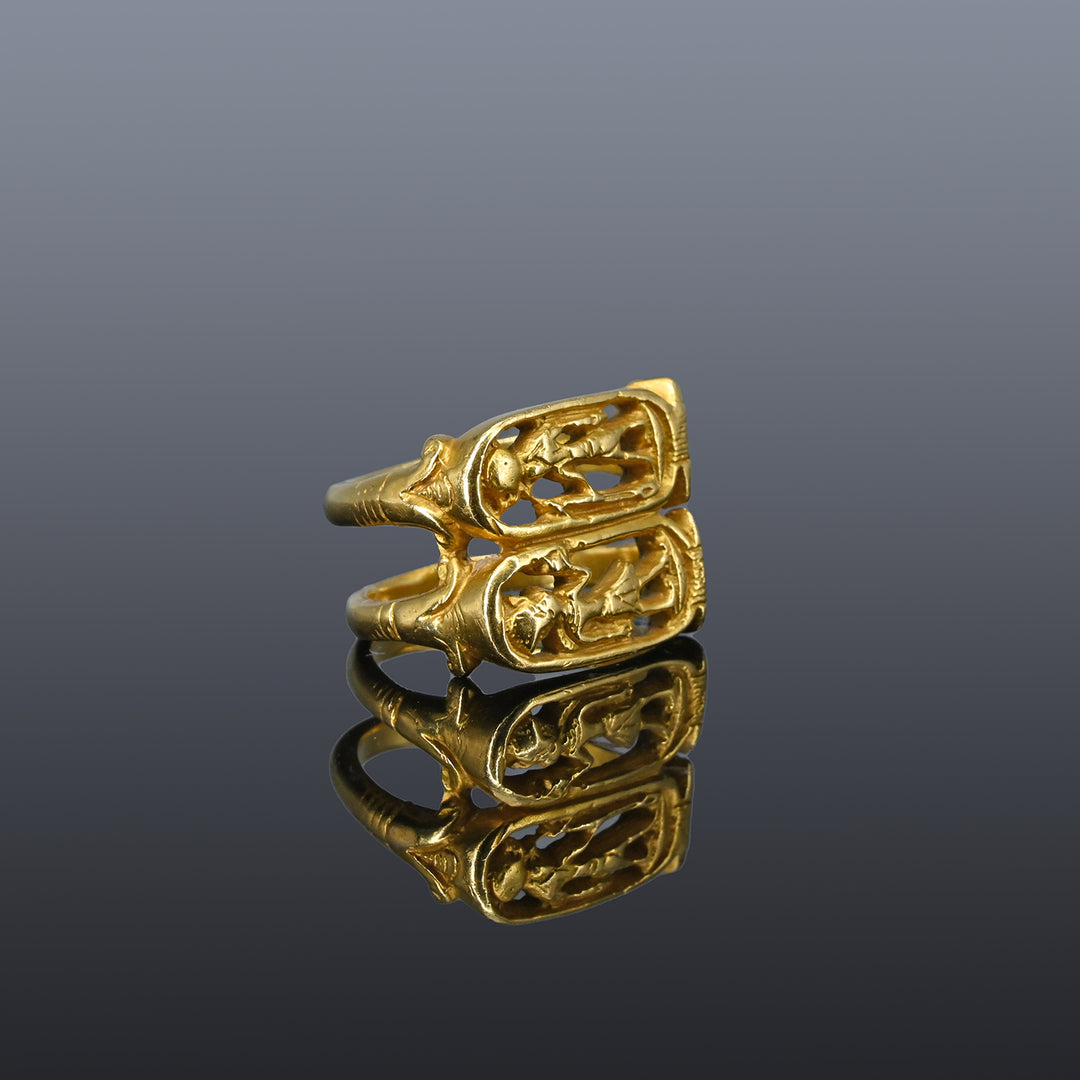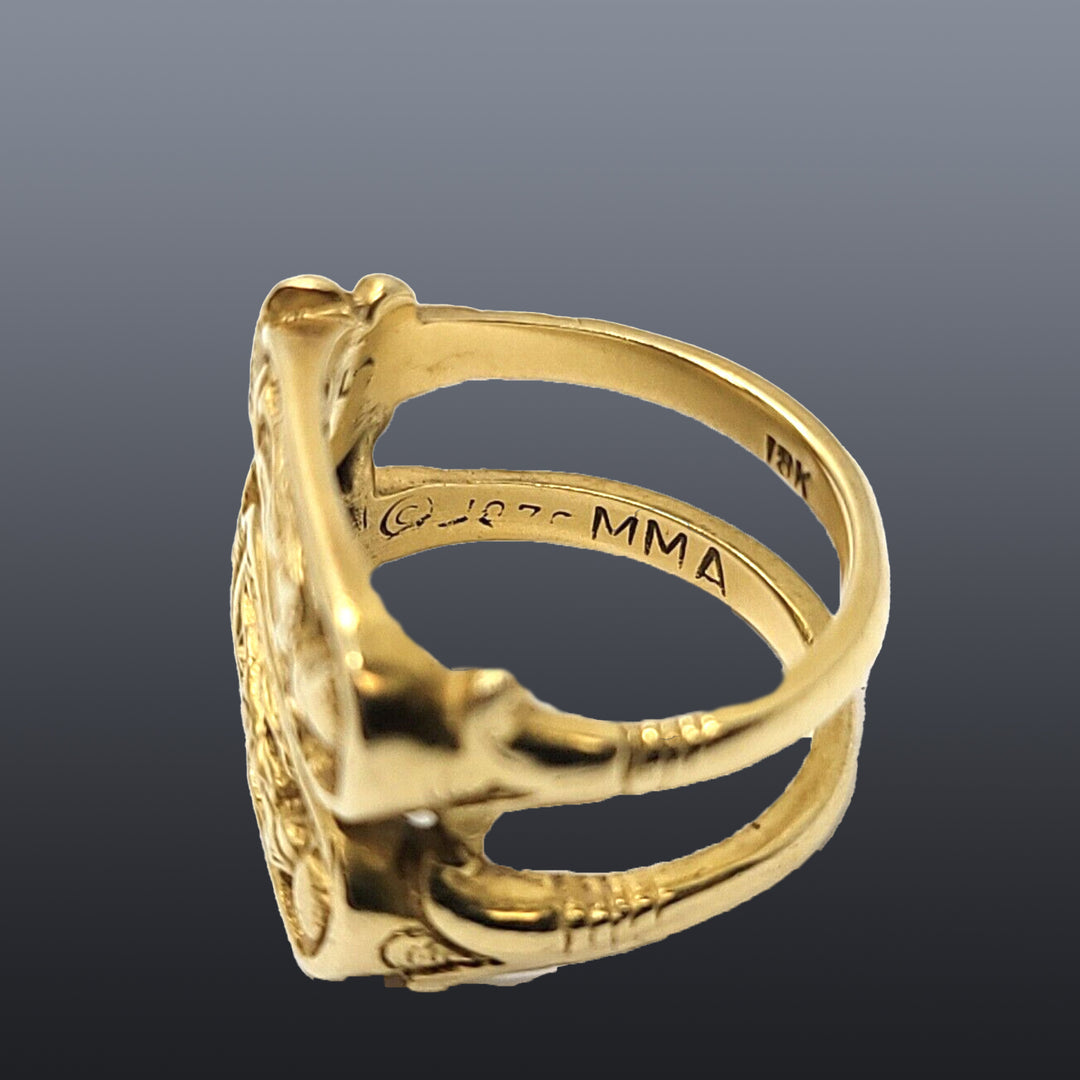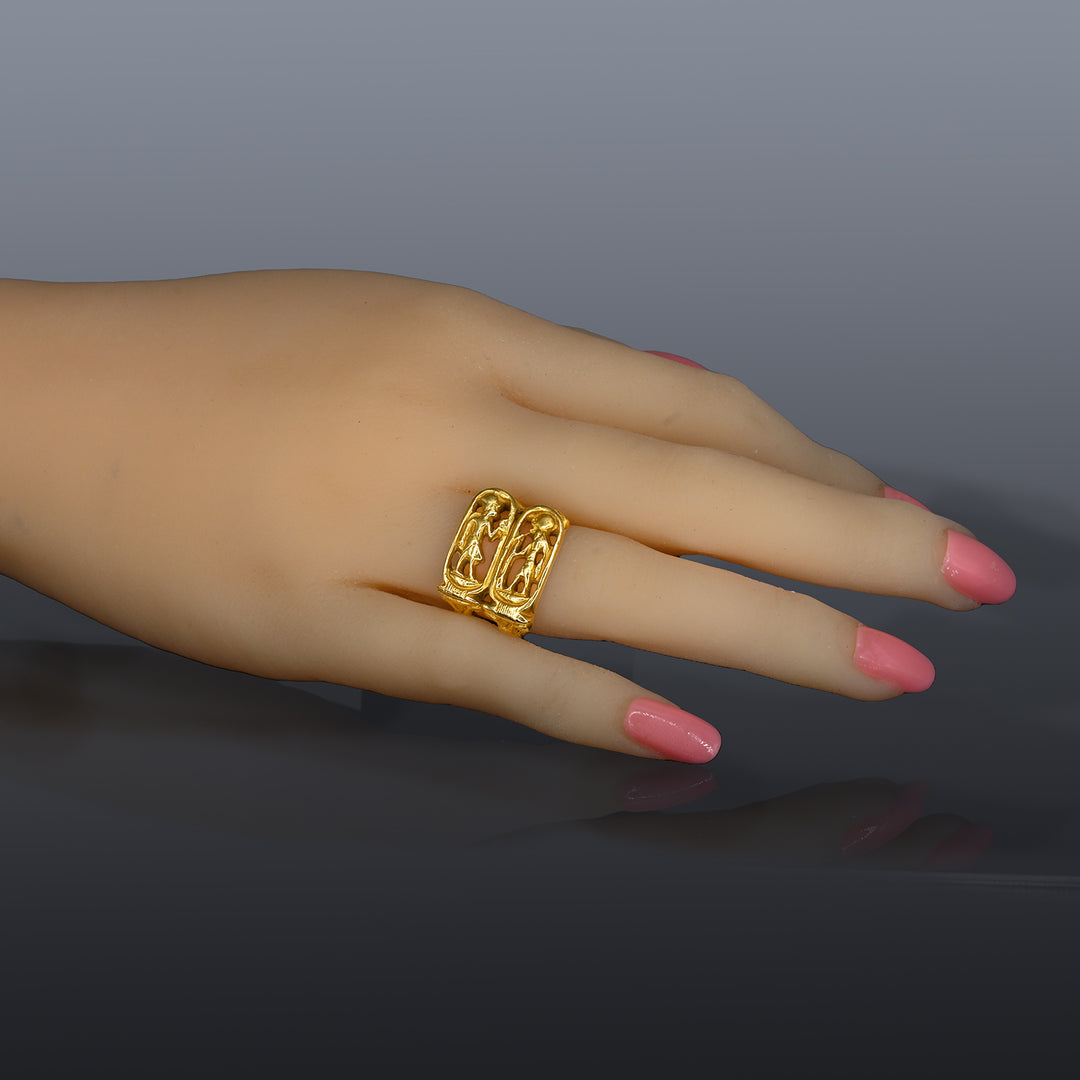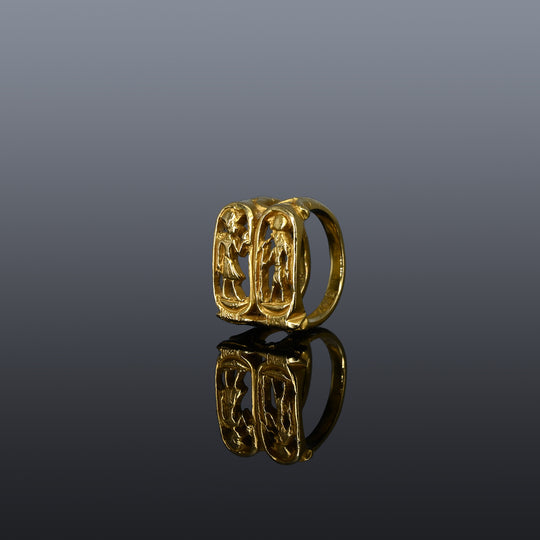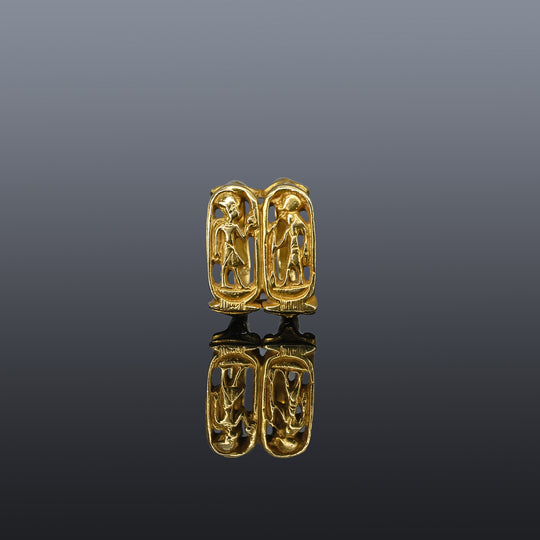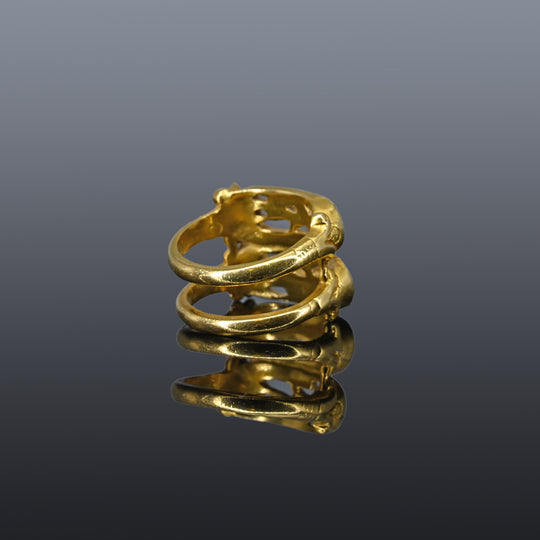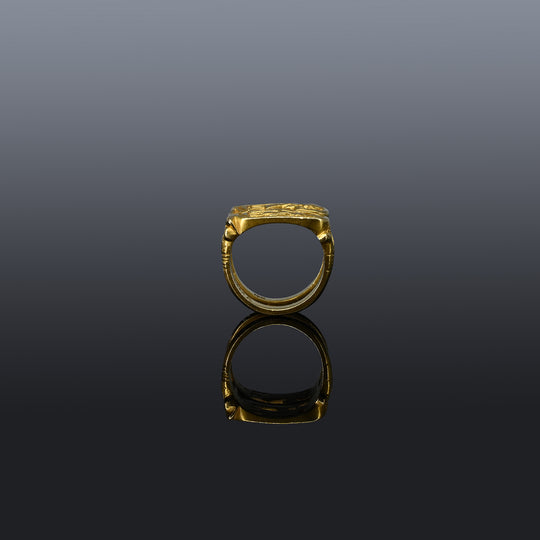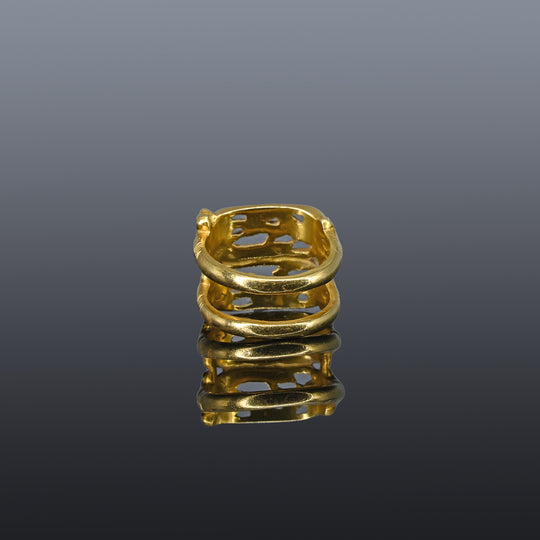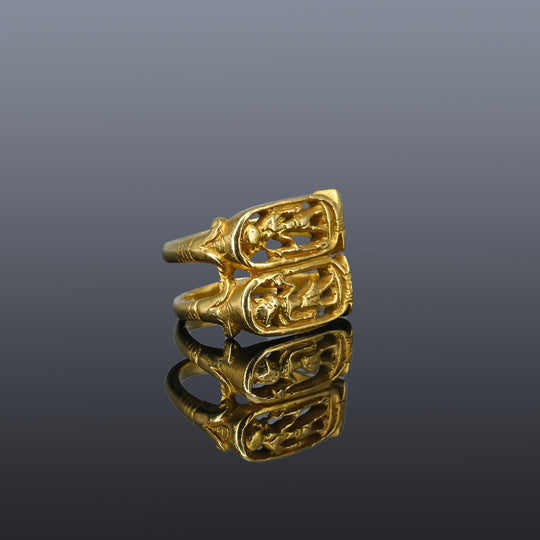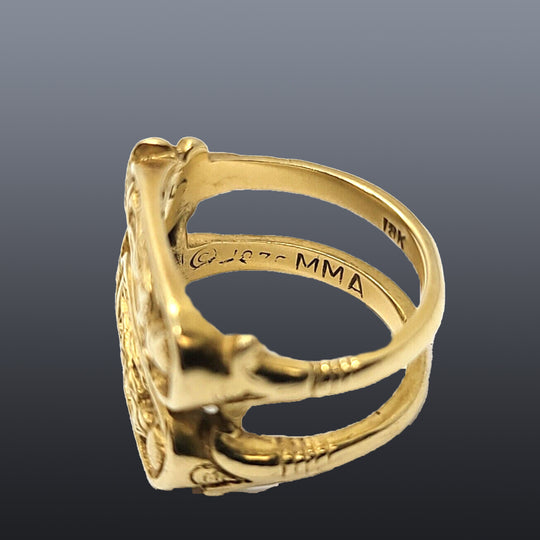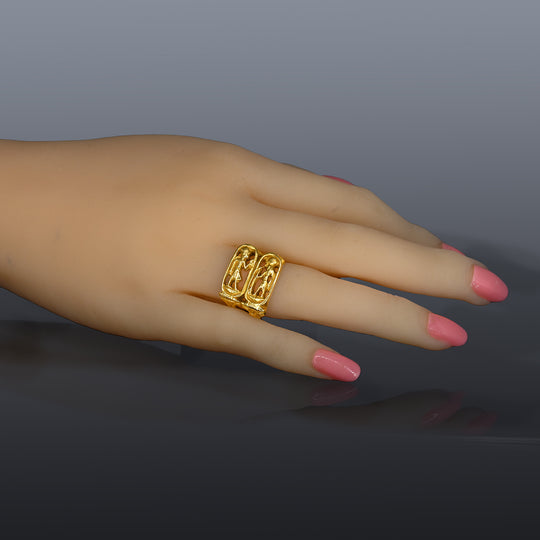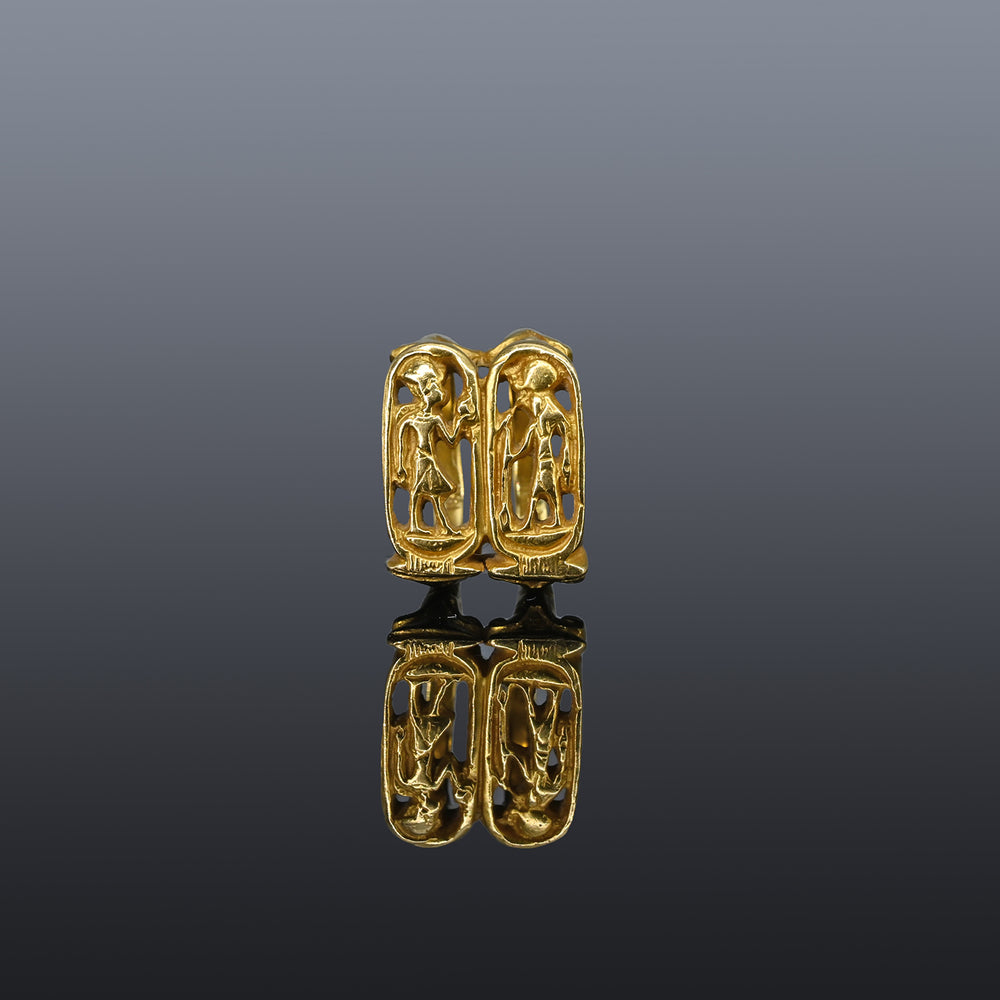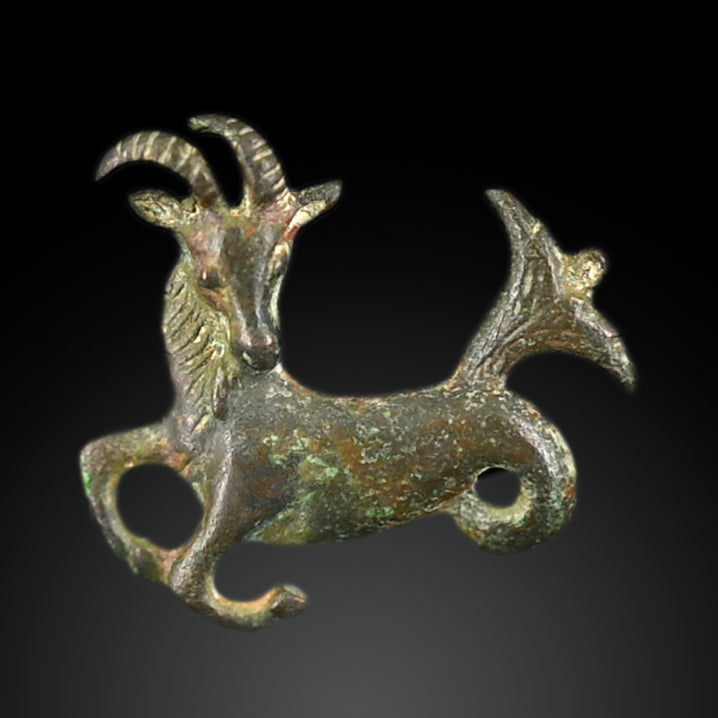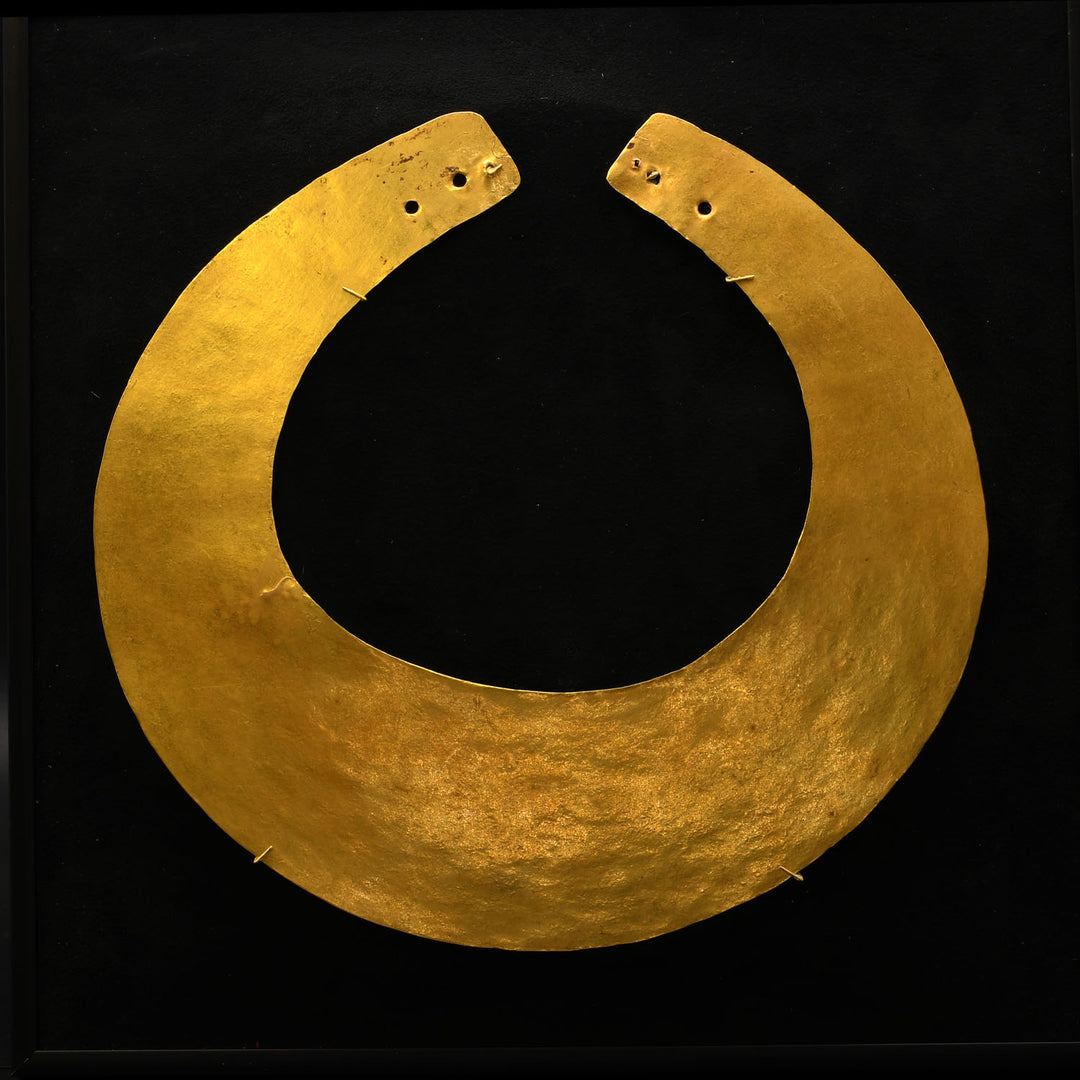"How’d you get so funky?" A 1976 King Tut MMA 18K Gold Exhibition Ring
EJ2308
- This object qualifies for free and fast worldwide shipping.
"How’d you get so funky?"
From November 1976 to April 1979, “Treasures of Tutankhamun” traveled to six American cities with the help of NEH grants. As millions of people lined up for hours to see the show, museums became the hottest tickets in town, helping usher in the era of the blockbuster museum exhibition. Tutankhamun, more commonly known as King Tut, has played an outsized role in our cultural imagination ever since archaeologist Howard Carter and his patron, the fifth Earl of Carnarvon, opened his tomb in November 1922.
Throughout the fall and winter of 1974 to 1975, the State Department negotiated with the Egyptians. It was decided the exhibition would start in 1976 and serve as a gift of friendship from Egypt to the United States during the bicentennial year.
The inclusion of a Tut show in the Nixon-Sadat agreement upended plans by the National Gallery of Art in Washington, D.C., to organize its own Tut exhibition. J. Carter Brown, the gallery’s director, had already received approval from Sadat and the Egyptian cultural ministry to host Tut in 1977 or 1978. Now that Tut had become part of Nixon’s diplomatic strategy, Brown wasn’t sure what role the National Gallery could or should play. Nevertheless, he offered the National Gallery’s services as the organizing institution.
Thomas Hoving, director of the Met, also stepped into the fray and soon was knee-deep in his own negotiations with the Egyptians. Having both the National Gallery and the Met vying to organize the Tut show complicated negotiations in Cairo. The museums had competed for decades, but the rivalry between Brown and Hoving was personal. Neither liked to lose—and Brown had consistently outmaneuvered Hoving in securing international shows. After the National Gallery beat out the Met to host another détente art show, “The Archaeological Treasures of the People’s Republic of China,” Hoving vowed to never lose another big show to Brown.
In the spring of 1975, the State Department asked Brown if the National Gallery would step aside and let the Met coordinate the exhibition. Hoving’s yearlong charm offensive in Cairo had worked its magic. Brown agreed, provided the Tut show opened at the National Gallery, in keeping with its bylaws, and the Met wasn’t given credit as the initiator of the exhibition. Hoving stewed over the Met being denied the chance to open the exhibition—Brown had once again managed to outmaneuver him—but calmed down when he realized, as he wrote in his memoirs, “that being last was actually better than being first—visitors would flood to the final opportunity to see the show.”
In late October 1975, Kissinger and Egyptian Foreign Minister Ismail Fahmy signed an agreement outlining the exhibition. “Treasures of Tutankhamun” would begin in Washington, D.C., travel to Chicago, New Orleans, Los Angeles, and Seattle, and finish in New York. Each museum would host for four months, with two months in between for packing, travel, and installation. By having the Tut show tour six cities, the Americans also trumped the Soviets—which is exactly what Nixon wanted. When “Treasures of Tutankhamun” toured the Soviet Union, it visited only three: Moscow, Leningrad, and Kiev.
When arrangements to transport Tut’s artifacts to the United States became hopelessly muddled, the U.S. Navy came to the rescue. The USS Milwaukee picked up the treasure in Alexandria, Egypt, and handed it off in Naples, Italy, to the USS Sylvania, which delivered it to Norfolk, Virginia, in early September 1976.
At each museum, the exhibition opened with a passage that mimicked the walk Carter took, back in the Valley of the Kings, from the steps to the second door. Visitors saw Tut first as a painted wood figure depicting him as the sun god: intense dark eyes, full lips, and an elongated skull. The figure, which would have allowed Tut to be continually reborn as the sun god, appears here because Carter discovered it beneath the rubble in the entranceway, most likely dropped by thieves as they scurried out.
From here, visitors progressed to the antechamber. A portable chest made of red and ebony woods is the only specimen of its kind that survives from ancient Egypt. A child’s chair, used by Tut when he was a boy, features gilded panels. Items from the burial chamber, including some that adorned Tut’s mummified body, were next. A lion carved of alabaster perched atop an unguent jar decorated with scenes of animals in combat.
When Carter opened Tut’s sarcophagus, he found three coffins, one nestled inside the next. Tut’s mummified body lay in the final coffin, a funeral mask covering his head and upper body. The mask, which for all of its golden glitz makes it seem as if the boy-king still lives, has become synonymous with Tut. Obsidian and quartz create his soulful eyes, while lapis lazuli sketches his eyelashes and eyebrows. A fake beard appears below his full lips, its plaits crafted from the same deep-blue glass as the stripes in his headdress. As a vulture springs forth from Tut’s brow, signifying his dominion over Upper Egypt, a cobra puffs up beside it, proclaiming Tut’s sovereignty over Lower Egypt. A wide collar inlaid with green feldspar, lapis, and quartz covers his chest, swooping up to finish with a falcon’s head perched on each shoulder.
Beneath the strips of linen, Carter found a necklace with an intricate pendant portraying the blue-winged vulture goddess Nekhbet. Another vulture, this one in the form of an elaborate gold collar with glass feathers in shades of turquoise, lapis, and jasper, spread its protective wings across Tut’s mummified body.
When the exhibition opened at the National Gallery on November 17, 1976, the line wrapped around the three-block-long building. Tickets were distributed daily, on a first-come, first-served basis, leading people to regularly queue up at dawn. To bring visitors in from the unusually brisk winter, the gallery snaked the line through the entire building. Even so, once they reached the Fourth Street NW entrance, ticketholders still faced a four-hour wait before they could walk down the west marble staircase and descend into the tomb.
President Carter paid his respects ahead of a visit by Sadat to discuss Middle East peace negotiations. Standing with Sadat on the south grounds of the White House on April 4, 1977, Carter called seeing Tut “one of the most exciting experiences that I have had.”
Members of Congress paraded through, as did Hollywood royalty. Elizabeth Taylor, who had played the legendary Cleopatra, took in the exhibition with her husband, John Warner. So did Robert Redford, Marisa Berenson, Rex Harrison, William Holden, and Stefanie Powers. Andy Warhol and Richard Avedon also stalked Tut.
When the exhibition closed on March 15, more than 835,000 people had seen Tut—more than the population of Washington, D.C. Visitors spent $100,000 a week (in 1976 dollars) on souvenirs. Exiting the show, they stepped into a store stocked with three hundred Tut-themed items developed by the Met. There were coloring books, posters, and postcards, along with a Tut tote bag. The Tut-inspired jewelry collection ran to one hundred pieces.
From Washington, the exhibition moved to Chicago’s Field Museum of Natural History, and people began lining up at five in the morning on April 15, 1977. A group of friends arrived after an all-night bar crawl. One lay on the museum steps “mummified” from head to toe in toilet paper. By nine o’clock, two thousand people were waiting. When the Field Museum halted sales at 1:30 p.m., it had issued 8,547 numbered tickets. Visitors receiving the last tickets faced a seven-hour wait, but could roam the rest of the museum before getting to see Tut.
On Monday, August 15, when the last visitor, Keith Feiler, an English teacher from Elmhurst, passed through the exhibition, the staff enlisted his help to reenact an ancient Egyptian ritual. After high Egyptian officials placed all of the items into a pharaoh’s tomb, they swept away their footprints as they exited. Using a replica of an ancient Egyptian broom, Feiler helped sweep away the footprints of the 1.35 million people who had come before him.
From Chicago, Tut moved to New Orleans, running from September 15, 1977, to January 15, 1978. John Bullard, the director of the New Orleans Museum of Art, confessed to having “nightmares” before its arrival. The museum had never hosted anything to rival Tut. One month before the exhibition debuted, group tours sold out. The museum also stopped offering memberships, which included access to the exhibition, after subscriptions climbed from 3,000 to 12,000.
When Tut opened, the line meandered into City Park. The museum erected a striped canopy over the sidewalk to provide shade. Sixteen portable “Tutlets” were also stationed nearby. Lelong Drive, which leads to the museum’s front steps, was painted Nile blue and the Fairmont Hotel served Sphinxburgers, Queen Nefertiti’s salads, and bowls of Ramses’ gumbo. When the doors closed, 870,594 people had seen the show and spent $75 million in town. The museum saw Tut off with a jazz funeral.
The show traveled next to Los Angeles, where it ran from February 15 to June 15, 1978. Rates quickly spiked in all of the parking lots surrounding the Los Angeles County Museum of Art. Ticket scalpers went to work. To manage the crowds, LACMA offered advance tickets at $2 apiece, selling out weeks before Tut’s arrival. By opening day, scalpers were selling tickets for $35 each.
From Los Angeles, Tut traveled north, opening at Seattle Center’s Flag Pavilion on July 15, 1978. Built for the 1962 World’s Fair, the pavilion was renovated to host the exhibition with the help of a $1.2 million grant from the federal Economic Development Administration. The Seattle Art Museum, the sponsoring institution, lacked the necessary facilities.
Unlike in Los Angeles, which drew the majority of its visitors from the surrounding area, the show in Seattle relied heavily on tourists. Tickets for packaged tours could be purchased in advance. Otherwise, numbered tickets—$1 for an adult and 50 cents for students and seniors—were sold daily starting at 8:30 a.m. Monitors around the Seattle Center and downtown displayed wait times and ticket availability. On select nights, the museum offered private viewings to groups, such as the Junior League and Boeing, for a premium of $7.50 to $10 a head. Afterward, visitors rode to the top of the Space Needle and sipped Tut-inspired cocktails. By the time he departed for New York, 1.29 million people had viewed Tut’s burial mask in Seattle.
After organizing the exhibition and watching it enthrall audiences from afar, the Met finally had its moment. To handle the crowds—and keep people from freezing in line during the New York winter—the Met offered its free tickets through Ticketron, which charged a small service fee. They went on sale on a rainy September morning, and the line stretched along Fifth Avenue from 80th Street all the way down to 59th. Tickets were sold out in six days, but when one New Jersey agency advertised Tut tickets for $20 apiece in the New York Times, it faced legal action. Scalping was illegal on both sides of the Hudson River.
During Tut’s run from December 15, 1978, to April 15, 1979, 633,500 out-of-town visitors descended on New York City, pumping $110 million into the local economy. When the Met closed its doors on the exhibition, 1.27 million people had gazed upon the objects the museum had helped Howard Carter excavate more than five decades earlier.
As the Tut show at the Metropolitan wound down, Steve Martin lamented on Saturday Night Live about how “we have commercialized it with trinkets and toys, T-shirts and posters.” Dressed like a dime-store pharaoh and backed by a band attired in Egyptian garb and two gyrating dancers, Martin delivered what became an iconic routine: “(King Tut) (King Tut) / Now when he was a young man, / He never thought he’d see (King Tut) / People stand in line to see the boy king. (King Tut) / How’d you get so funky?” Halfway through the song, a saxophone player in head-to-toe Tut garb emerged from a sarcophagus at center stage. As he riffed on the song’s melody, Martin placed a blender before him as an offering.
While Nixon and Kissinger wanted the Tut show for diplomatic reasons, there was no denying, as Martin so deftly pointed out, that the exhibition made money for its host museums, savvy retailers, and local economies.
Most importantly, the exhibition captured the imagination of the American public, making Tut and his enchanting treasures part of the cultural zeitgeist of the 1970s.
This 18K solid gold ring was one of five gold rings issued by the Met as part of the jewelry collection commemorating the exhibition. Fifteen rings, some with swivel bezels, were found on Tutankhamun's mummy, but only two were actually placed on his fingers; the remainder were bound in the linen wrappings, five over the right wrist and eight beside the left wrist. In addition, eight rings, which the ancient robbers had inadvertently left in the tomb wrapped in a piece of linen, were found in a gilded chest in the antechamber, where they had no doubt been placed by the necropolis staff. Five of these twenty-three rings were chosen by the Met. This example, made of 18K solid gold is a bipartite ring; the two openwork loops in the form of cartouches, have lily-form terminals soldered together at their bezels. Each bezel is decorated in openwork with a figure standing on the basket hieroglyph neb, which is often used to fill the oval base of a cartouche. On the left bezel, the figure represents the king presenting an offering. The offering is received by the falcon-headed sun-god, Ra-Harakhty, shown in the right cartouche wearing the sun's disk and uraeus, holding the was scepter in his right hand and the ankh sign in his left. The two loops are engraved with a wadjet eye on one side and a baboon on the other.
Bibliography: "King Tut: A Classic Blockbuster Museum Exhibition That Began as a Diplomatic Gesture" By Meredith Hindley | HUMANITIES, September/October 2015 | Volume 36, Number 5
Dimensions: US ring size 5 (ask us about resizing)
Sands of Time provides a lifetime, unconditional guarantee of authenticity and provenance. Every object you purchase from us is accompanied by a Certificate of Authenticity, stating culture, provenance, and age.
Furthermore, we conduct due diligence to ensure the item, to the best of our knowledge, has not been illegally obtained from an excavation, architectural monument, public institution, or private property. Wherever possible, reference is made to existing collections or publications.Wherever possible, reference is made to existing collections or publications.
We ship Tuesday to Friday with FedEx and usually same day if your order is received before 2pm. Within the continental USA, packing, shipping and insurance is free. Depending on size and destination, delivery times range from one to five business days.
If we are shipping this object to you overseas, there is no charge for packing, preparation of all customs paperwork, insurance and carrier fees in compliance with all USA and International customs requirements.
We send overseas shipments with FedEx International Priority which usually means two to three day delivery to Europe and the UK, customs willing but contact us if you have a shipping preference.
Please note: International customers are responsible for all duties and taxes.
